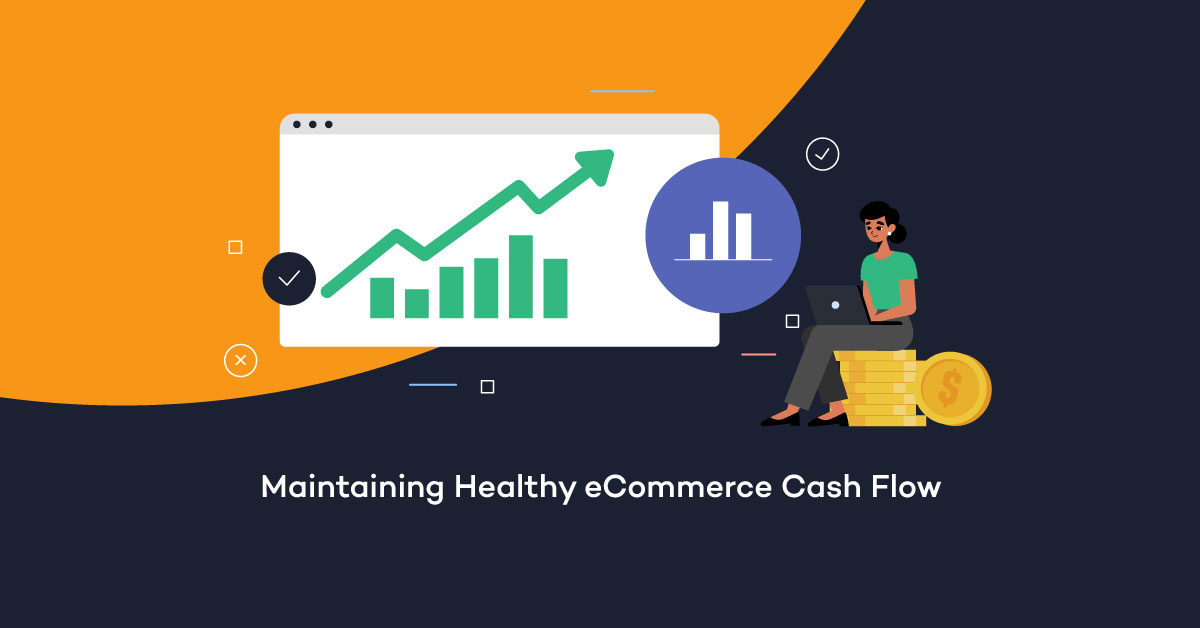Poor cash flow is the number one reason small businesses fail. eCommerce businesses (even profitable ones) are all too familiar with the constant battle for healthy cash flow. Inventory requires large down payments and short invoice terms.
PPC investments begin long before a product starts making money. Marketplaces hold sales revenue for weeks before payout.
Online sellers must overcome built-in eCommerce cash flow hurdles, and it requires intention. Here are five ways you can maintain and improve your cash flow.
Track and Forecast Your Cash Flow
Understanding your cash flow is the first step to improving it. The first thing you should know is that cash flow is different from profit.
If you sell on Amazon, you know that sales do not immediately generate money in your bank account. That means sellers often have a hard time understanding their cash flow, even if they have profitable listings.
You need to know when to expect sales to hit your account, when your expenses are due, and where any gaps could put pressure on your business. Cash flow issues can lead even profitable eCommerce businesses to suffer stockouts, late payments to suppliers, and poor performance in peak season.
The best way to prepare is to forecast cash flow as much as possible. Projecting sales and expenses will help you identify months where you may need extra cash.
This allows you to plan for growth and investments in inventory or marketing campaigns. A solid understanding of your cash flow cycle also allows you to better manage any debts or loans you may have.
Don’t Just Plan Plan Product Launches; Plan Successful Launches
Most successful sellers are pretty good at finding addressable markets where they can sell a product. They research the customers, the competition, and the price points that will make them successful. But too often, product launches are underfunded when sellers fail to budget the cash required to maintain momentum.
Again, we return to the lag time between launch, sales, and finally, payout. Whatever you budget for your first order of inventory, a successful launch means you’ll need a second order (and possibly a third) before you start collecting on your sales. Without the available cash, you risk stockouts and production delays that will kill your momentum.
Planning a successful launch means budgeting enough cash to carry momentum beyond the first month. You should be able to pay for (and market) your first three orders of a new product. By the time you need a fourth-order, you’ll have a revenue stream to support your investment.
Write a Budget and Hold Your Business Accountable
One of your most important jobs as an online seller is creating a budget. It should include fixed costs like labor, rent, and utilities as well as variable costs such as marketing expenses, inventory, or materials for product launches. When you’re just starting out, a simple spreadsheet will do the trick.
Annual and quarterly budgets can be flexible. If your business exceeds targets, you can always budget for new investments and growth opportunities. But documenting an initial budget will help you drive accountability for yourself and your business expenses.
Negotiate With Suppliers and Vendors
Negotiating expenses is another great way to improve your eCommerce cash flow. Look for ways to reduce costs without sacrificing product quality or customer service, such as negotiating better rates with suppliers or vendors.
Keep in mind that “better rates” don’t always mean “cheaper rates.” One of the primary cash flow challenges eCommerce businesses face is that expenses are often due before the business gets paid.
One solution is to extend payment terms with your suppliers and vendors. If you can get terms extended from net 30 to net 60 on a large order of inventory, you will already start selling the inventory by the time the payment is due.
This is an improvement for your cash flow, even if your bottom line hasn’t changed at all. This way, you can invest existing cash reserves in growth rather than using them to pay an invoice.
One more option: you could offer to pay your supplier upfront in exchange for a discount. Where do you get the cash to pay upfront? Secure working capital at a cost that’s less than your negotiated discount. Now, you’re saving money and improving cash flow.
Factor in Seasonality
For most businesses, revenue does not form a straight line throughout the year. Neither do expenses. The challenge for eCommerce sellers is that the high expense seasons often precede revenue spikes. The most common example is the race to stock up for the holidays.
Many sellers start ordering during the summer months, knowing they won’t see the sales revenue until December or January. Without a budget and a plan, this will create a major cash flow strain.
Have a plan for how you will maximize your ability to invest in growth when demand is high, and a few ways to do that:
⚫ Use funding to order seasonal inventory and to restock it after Black Friday, if necessary.
⚫ Communicate your needs with suppliers in advance, and negotiate for the best possible payment terms for your business.
⚫ Trim your expenses during the lean sales months as much as possible. Reduce spend on marketing campaigns, software subscriptions, and labor to be sure you have as much cash as possible for inventory when you need it.
Most sellers focus primarily on their top line. While revenue is required for growth, the true health of your eCommerce business depends on cash flow. By following these tips, you can ensure your eCommerce business has a healthy cash flow and remains profitable.
——
About the Author:
Viably is an eCommerce funding software to help sellers extend their cash flow. It includes free financial management tools like business banking and cash flow forecasting.



